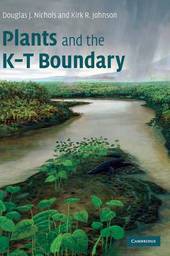
|
Plants and the K-T Boundary
Hardback
Main Details
| Title |
Plants and the K-T Boundary
|
| Authors and Contributors |
By (author) Douglas J. Nichols
|
|
By (author) Kirk R. Johnson
|
| Physical Properties |
| Format:Hardback | | Pages:292 | | Dimensions(mm): Height 255,Width 180 |
|
| Category/Genre | Botany and plant sciences
Geology and the lithosphere
Palaeontology |
|---|
| ISBN/Barcode |
9780521835756
|
| Classifications | Dewey:561.117 |
|---|
| Audience | | Professional & Vocational | |
|---|
|
Publishing Details |
| Publisher |
Cambridge University Press
|
| Imprint |
Cambridge University Press
|
| Publication Date |
15 May 2008 |
| Publication Country |
United Kingdom
|
Description
In this text, two of the world's leading experts in palynology and paleobotany provide a comprehensive account of the fate of land plants during the 'great extinction' about 65 million years ago. They describe how the time boundary between the Cretaceous and Paleogene Periods (the K-T boundary) is recognised in the geological record, and how fossil plants can be used to understand global events of that time. There are case studies from over 100 localities around the world, including North America, China, Russia and New Zealand. The book concludes with an evaluation of possible causes of the K-T boundary event and its effects on floras of the past and present. This book is written for researchers and students in paleontology, botany, geology and Earth history, and everyone who has been following the course of the extinction debate and the K-T boundary paradigm shift.
Author Biography
Douglas J. Nichols is a Research Associate with the Department of Earth Sciences at the Denver Museum of Nature & Science and a Scientist Emeritus with the United States Geological Survey (USGS). He received his Ph.D. in geology from The Pennsylvania State University before pursuing a career that has included university teaching, the oil industry, and 30 years of research with the USGS. Dr Nichols is a palynologist, with research interests in the fossil pollen and spores of Upper Cretaceous and Paleogene rocks, with emphasis on biostratigraphy, paleoecology, evolution, and extinction events. In 2005 he received the Meritorious Service Award from the U.S. Department of the Interior for his research on the biostratigraphy of nonmarine rocks and the Cretaceous-Paleogene (K-T) boundary in western North America. Dr Nichols is the author or coauthor of more than 140 scientific papers and has served as an editor of the journals Palynology and Cretaceous Research. Kirk R. Johnson is Vice President of Research & Collections and Chief Curator at the Denver Museum of Nature & Science (DMNS). He joined the DMNS in 1991 after earning his doctorate in geology and paleobotany at Yale University. Dr Johnson's research focuses on Late Cretaceous and early Paleogene fossil plants and landscapes of the Rocky Mountain region and is best known for his research on fossil plants, which is widely accepted as some of the most convincing support for the theory that an asteroid impact caused the extinction of the dinosaurs. He has published many popular and scientific articles on topics ranging from fossil plants and modern rainforests to the ecology of whales and walruses, and co-authored the book Prehistoric Journey: A History of Life on Earth.
ReviewsReview of the hardback: '...a superb discussion on what the plant record tells us about the causes of the mass extinction across the boundary.' Bulletin of the British Ecological Society Review of the hardback: '... a sound, clearly written and well-documented book ... The authors, a palynologist and paleobotanist, have done a great service to the scientific community in bringing together the many lines of evidence ... to provide a clear and detailed picture of the nature of the plant life at the close of the Cretaceous and the beginning of the Paleogene. ... We recommend this book to all who take an interest in the geologic history of our Earth.' Newsletter of the AASP (The Palynological Society) Review of the hardback: '... this book is an important contribution to the literature of both palaeobotany and palynology and is of interest to any plant scientist concerned with the capacity of the terrestrial flora to respond to major environmental change.' Annals of Botany
|